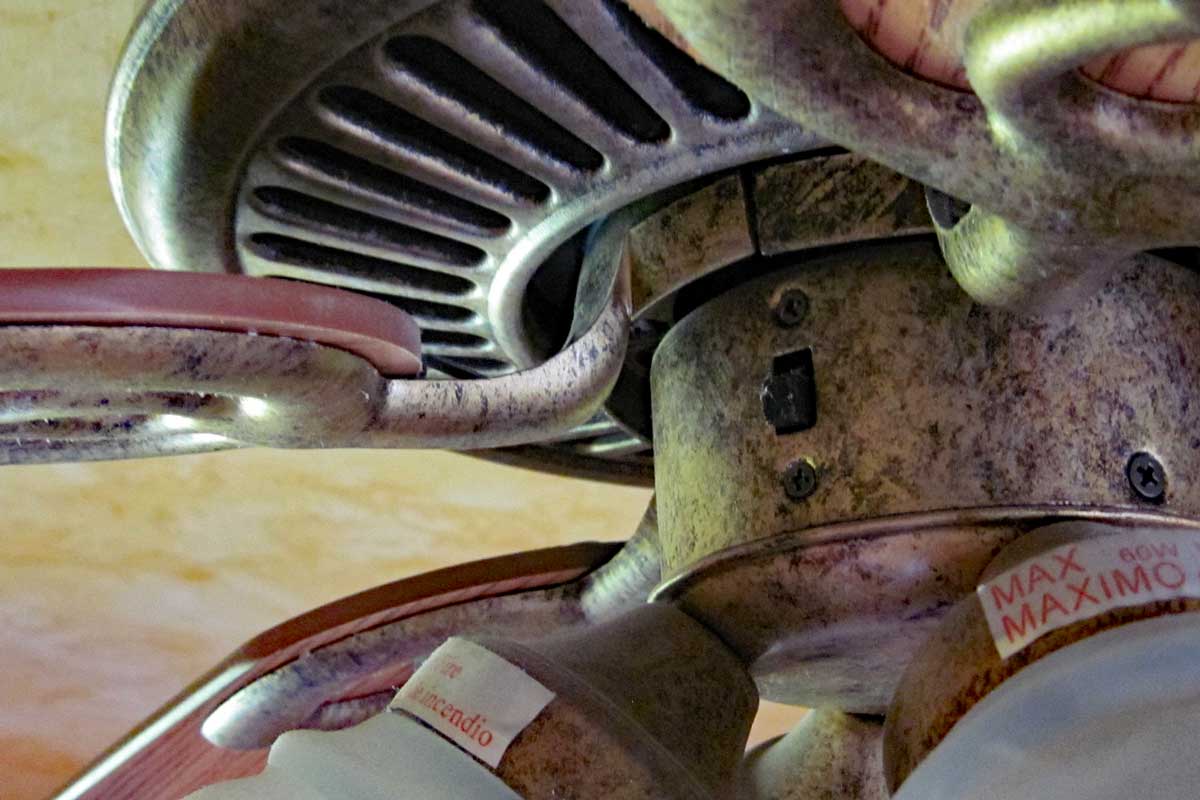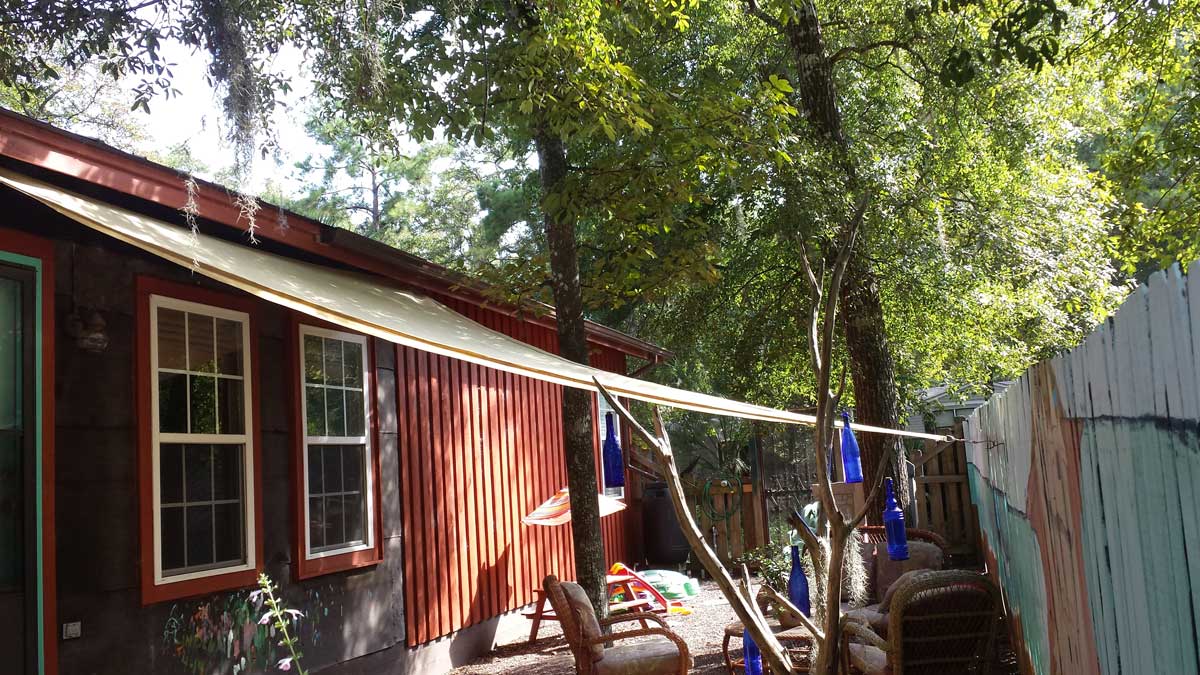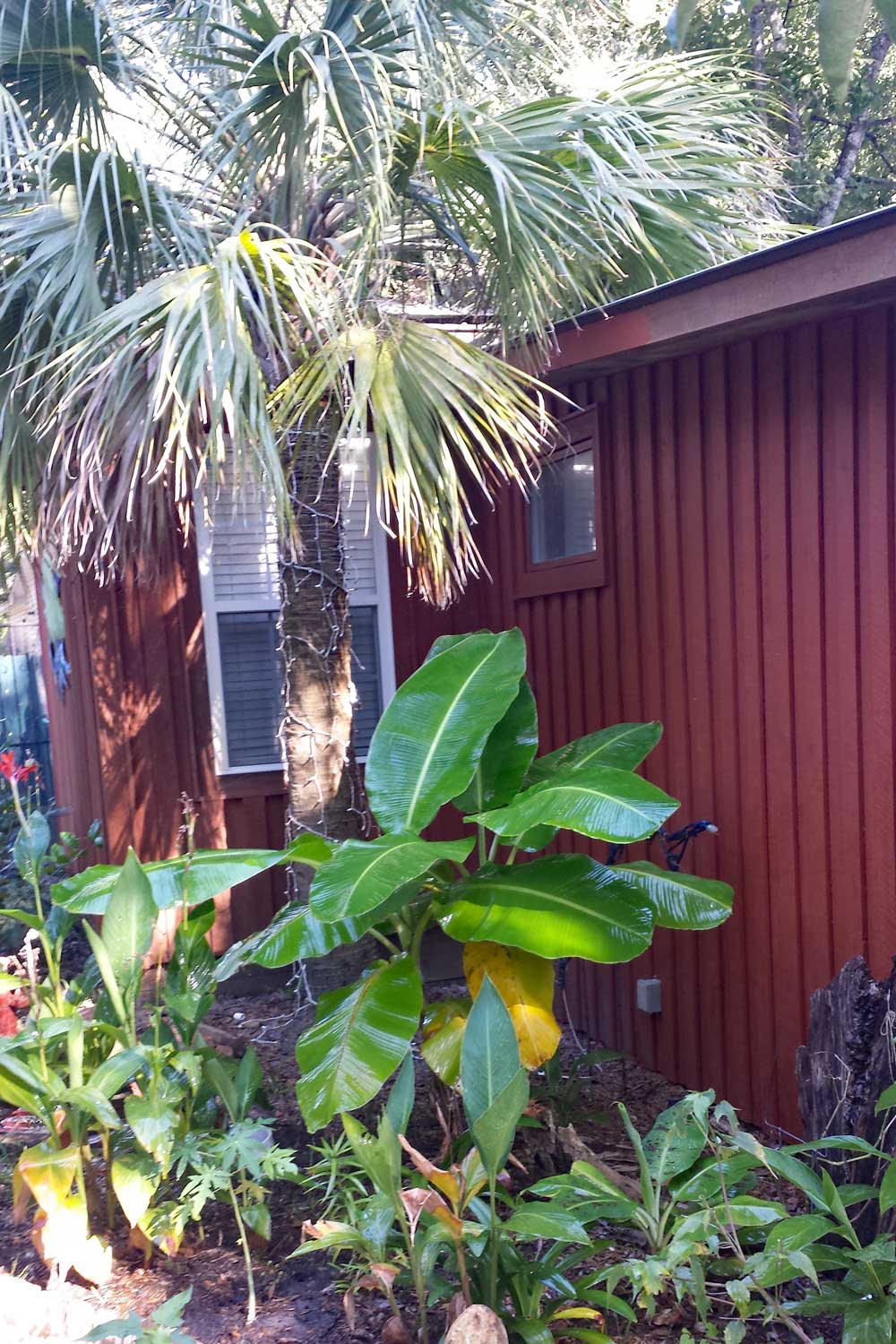12 Best Tips for Keeping Your House Cool without AC
This post may contain affiliate links. Read my full disclosure here.
Summertime may bring many wonderful things but the extreme heat is not one of them. For many, using air conditioning is not affordable nor available. Here are some tips for keeping your house cool in the summer heat, with or without AC. We use these techniques in steamy South Carolina to reduce our air conditioning bill. Scroll down to see 12 ways to keep house cool without AC.
Note: See the post “Heat Stroke – Symptoms, Treatment and Prevention” for more tips on staying safe in high temperatures.

How to Keep House Cool Without AC
#1 – Dehumidify
If you live in an area with dry heat your body perspires, your sweat evaporates, and you cool off – just the way nature intended. If you live in an area with lots of humidity (which I do) you sweat and it doesn’t evaporate. Instead it soaks your clothes leaving you feeling hot, wet, sticky, and miserable.
To feel cooler in high humidity:
- Wear loose cotton or other natural fabric that breathes
- Choose breathable sheets that keep you cool, such as cotton or bamboo
- Use a dehumidifier
A dehumidifier helps remove excess moisture from the air, which leaves you feeling cooler even in hot temperatures. You can find dehumidifiers at most big box stores, Craigslist, classifieds, and online.
See also “Musty Smells in the House – Finding Them and Getting Rid of Them” for help dealing with humidity related odors.
#2 – Unplug
Everything you plug into a socket produces heat. Unplug all unnecessary appliances or electronics when not in use. Even those little red glowing lights that stare at you in the middle of the night indicating the item is turned off drain energy and produce heat. Turning something off is not enough – unplug.
#3 – Use Natural Light and High Efficiency Lighting
Take advantage of daylighting or use energy efficient light bulbs, such as LEDs, in your high use areas. A traditional 1oo watt light bulb can increase the heat by 11 degrees per hour in a small room.
Some utilities offer rebates on LED lightbulbs, making them more affordable. You can view a list of LED rebates by region and bulbs that qualify for rebates here.
Also, consider using lighter paint and finish colors in your home. Light colors reflect more light and reduce your need for extra task lighting (reducing heat generation).
#4 – Don’t Cook or Cook Outdoors
During the summer months, try to pre-plan meals so that you don’t need to use the oven during the day. Either cook on the grill, in a microwave, or in a crock pot. If you have to use the oven, try to cook your meal before noon or after the heat of the day. I would suggest around 4 pm.
Editor’s note: Traditional Cooking School has an e-course on outdoor cooking options include using portable appliances outdoors, propane camp stove cooking/canning, charcoal grill, solar oven, open fire cooking, smoking, and more. If you sign up through links on my site, I receive an affiliate payment at no extra cost to you. You’ll love Wardee’s easy to follow instructions.
#5 – Close your blinds from late morning until early evening
“Let the Sun Shine In” is a cute song for children, but not helpful for keeping your home cool. Close your blinds from late morning until early evening. This simple act can keep a room 10-15 degrees cooler.
You can purchase blackout shades, use window tint film on your windows (easy to install), or good blinds. If covering your windows during the day makes it too dark, you can lower the top of your shades 6″ from the top of the window to let light in but not the heat.
If you can’t shade the outside of a window consider insulating cellular shades. These can keep the heat from penetrating as much into the house.
#6 – Use Ceiling Fans – The Right Way
Did you know there is a right way and a wrong way to use your ceiling fan?
The base of your ceiling has a small switch that changes the direction of the air flow. During the summer months your ceiling fan should blow forward in a counter-clockwise direction, forcing air down and making you feel cooler.
During the winter months your ceiling fan should blow in a clockwise direction, circulating the air through the room without blowing directly on you. This doesn’t necessarily cool down a room, but it increases the evaporative cooling from your skin, making you feel cooler.
Newer homes are very tight, so ceiling fans can also keep the home airflow going without a major expense.

#7 – Shade the outside of your windows
A completely dark house during the summer with all of the shades closed makes me depressed and drives me crazy. My husband, (aka energy police who I swear has some vampire blood running through him) would paint our windows green polka-dots if it saved on our electricity, so we made a compromise. I found this very affordable and stylish shade that we installed on the outside of our house over our windows that still lets the light through, but blocks the heat.
Would you like to save this?
You can also put up an umbrella outside your window to block the afternoon sun and pretend you’re at the beach! Or even install awnings or overhangs. A porch on the 2nd floor can act as an overhang for the 1st floor windows.

#8 – Vent the Hot Air Out
Use stove top vents, bathroom and laundry room vents to dump hot, humid air from cooking and showering outside.
Being frugal and trying to save on your electric bill isn’t just about your wallet. With every watt you save you are reducing your environmental impact.
#9 – Cool Down a Room or Get a Personal Cooling Fan
Close off rooms that are not in use, and focus your cooling efforts only where you need them. Figure out how to cool down a room or cool down people.
Cold air fans and personal fans targeting a small area use a lot less energy than cooling an entire home. This portable handheld fan comes with a rechargeable battery to provide cooling in your home or on the go.
Some of the best rated cooling fans for rooms include:
Vornado Large Whole Room Air Circulator Fan
Klarstein Silent Storm Pedestal Fan
#10 – Plant Shade
This takes some time to establish and a little bit of planning but will provide you win-win results. A tree in full bloom can block over 70% of solar radiation from entering your home. Sun-loving, shade providing plants, trees and shrubs in front of windows that receive the afternoon sun to cool down your house and add beautiful landscaping to your yard.
Trees and foliage also lower surface and air temperatures by providing shade. They also breathe in CO2 and breathe out oxygen and water vapor (called evapotranspiration). Trees and foliage can reduce the temperature by 20 to 45°F (11–25°C) than the highest temper for un-shaded surfaces, such as asphalt. The difference will be less in your home but even a 5 to 10°F drop will make a big difference, a larger area helps increase the shading effect.
Keep any trees/plants in pots that need to be brought in during winter months or that have an aggressive root system.
Heat Tolerant Plants that Help Provide Shade:
- Sunflowers
- Corn
- Banana Plants
- Palms
- Cannas
- Dwarf Fig tree
- Lemon Grass
- Crape Myrtle Tree
- Mimosa tree
Editor’s note: In cooler areas of the country, just about any deciduous plant will do.

#11 – Get a Cool Roof
Have you ever gone out in the sun in a black t-shirt? Or thought about why DIY solar heaters are painted black? Because they absorb heat. So why are all shingles black?
Most shingles are black because they are made out of tar. Cool Roofs are ones that reflect sunlight.
Cool roofs stay cool, and reduce the amount of heat transferred to the home. According to the CRRC (Cool Roof Rating Council) if you do not have air conditioning, Cool Roofs can drastically reduce a home’s internal temperature. If you do have air conditioning, adding a cool roof can save the you up to 15% off your cooling bill.
So how do you get a cool roof? One of the most affordable ways is to paint your roof with a light colored paint specifically for roofs. Almost every type of roofing can be painted, even shingles, but before you start slinging a paint brush make sure you check with your roofing manufacture to see if painting it voids your warranty.
#12 – Invest in Better Doors, Windows and Insulation
While you’re checking out the roof, consider more energy efficient options for windows, doors and insulation. Better insulation and tighter seals will help you keep your home cooler in extreme heat and warmer in winter with less energy.
More Posts On Sustainable Living
- Solar Energy Questions and Answers, Pros and Cons
- What’s the Best Solar Cooker?
- Solar Emergency Gear – Lights, Power, Radios, and Ovens

This post is by Amber Bradshaw of My Homestead Life.
Amber and her family moved from their tiny homestead by the ocean in South Carolina to forty-six acres in the Smoky Mountains in East Tennessee.
While building their off-the-grid homestead, they live like the days of old – cooking without electricity, collecting water from the creek and raising chickens, goats, pigs, turkeys, bees, and guineas. They’ve recently filmed their journey for a TV show on the Discovery Channel and the DIY Network/HGTV called Building Off The Grid: The Smokey Mountain Homestead.
Originally published in 2014, last updated in 2018.




To cool down..put on a wet t-shirt….when it dries, remove it and put on another wet one!
Very good information..I will be following it.
They make roof shading systems, and a double roof works as well as long as both have adequate ventilation. make sure to place metal screening material that hornets and wasps cannot get into to save yourself the trouble of nests in impossible to reach places. You can also add double walls to your home that have space between the main wall and the outer wall. Make sure that they are an off tint of white or light cream color to save even more money and keep temperatures down.
Any idea about the cost to build something like this, and ongoing maintenance? We looked at envelope houses (double exterior walls) back when we built this place (2004), and at that time they were cost prohibitive.
In the thousands range to do it yourself upwards of $10,000 for the double roof because you have to buy the lumbar the metal sheets etc. The cloth system I spoke of costs about $5,000 but personally I would go for something more solid. I got an estimate for roofing with just the aluminum sheeting and it was $19,000.
Thanks a lot for publishing this post! It is very useful!
You’re welcome.
I live in a 1967 concrete block/no insulation house in central Florida- Orlando area- not by the water. Already we are having 100°. No breeze. We cannot have trees within 60′ feet. Of the house due to risk of hurricane winds blowing trees on the houses. The roof is a low slope 5 year old metal (no color, just shiny), 12/1.2 with no attic/crawl space to insulate. I have grown up using all the cooling techniques you mention that I can. It is not financially feasible for me to rebuild the roof to add insulation or add vinyl siding lined with insulation. Any other suggestions? I think you left out using good LED bulbs as they give off minimal heat. Thanks..
RE: LED lighting – see point #3:
Beyond that, I think the post covers most options that are readily available.
If you can’t plant trees, shrubs and shade cloth could still block sun gain from windows and exterior surfaces. Having more taller vegetation in the area (even if you can’t have it right next to the house) tends to create a cooler microclimate than pavement or lawn. This could make your yard slightly cooler than it might otherwise be, indirectly cooling your home.
You can find videos on YouTube on how to refit your home yourself cheaply using geothermal heating and cooling techniques. You can change the temperature inside your home by up to 30° by installing PVC pipes underground in your yard that connects to vents you install inside your home in each room. A small reversible fan inside the pipe allows you to control the airflow direction depending on the season. The cost of running the system is no more than what a small desk fan would cost you to run. This works because the temperature underground is always the same year round and because it is cooler underground during the summer and warmer underground during the winter than it is outside. The intake vents are screened installed with a small drainage box so you don’t have to worry about bugs, vermin, or rainwater getting in the pipes. The depth the pipes must be installed depends on your region and there are charts available online. I hope this helps.
Hey Amber, these are some great tips indeed. While reading tip #12, I remembered an article I saw on The Washington Post stating the The U.S. Department of Energy said that we can reduce our heating and cooling needs by almost 30% if we smartly insulate our homes!
How many people just never think about proper insulation! Anyways, great article!
this is great
I have a dehumidifier in by basement and use it when I notice the water pipes sweating and dripping on the cement floor. It fills the reservoir in less than a day and I use the water for outside flowers. I use my furnace fan to send cool air from the basement through the air vents which helps cool my house plus circulates air plusI have 4 ceiling fans. I have bubble wrap on most windows that is cut to fit and needs only water sprayed on the window to make it stick. It helps keep out cold, heat and is also good for privacy. I live in Ontario Canada and we get high humidity in summer that makes it feel much hotter than it really is. In a recent heat wave the temperature went to 100-120 f. There were many heat related deaths (30-50+) in Quebec. I sometimes also cool off in front of a fan with a cold wet face cloth.
I live in Canada (Ontario) and we get heat waves and lots of snow and freezing winters. I made what I call a “window quilt” the first winter to keep the cold coming in at night through a large living room window. It also works to keep out summer heat. This window is on the east side of my house where there are no trees and most of the heat comes in. I made this quilt out of a large white sheet (doubled) and stitched a quilt batting inside it. I used cup hooks under the top window frame and sewed plastic rings on the quilt to match each hook. I also am able to roll it up and have long ties that can be tied or released when needed. I have plants and seedlings on shelves in front of the window but when it got too hot I dropped the quilt and put them outside where they get part shade.
I live in Canada as well. Such weather extremes here.What part do you live in? Very great idea your window quilt. My house is old with old Windows , I must try tbis.
When we lived in Madison WI our summers were hot and typically very humid. We got a dehumidifier, It helped dry our air, but also generated a noticeable amount of heat. We tried running it wile at work during the day in our tub where it could drain freely, and turning it off at night. Could this increase of heat indicate that we were operating it incorrectly? We now live up North where we have a few hot, humid days each summer. I think we still have the dehumidifier in storage and wonder how it can be used to dehydrate without increasing heat? Our cottage is about 525sf with a 14 ft open beam ceiling and good insulation. We get pretty good shade on the south and west sides from the forest around us and cool off at night except for those few miserable nights each summer.
All dehumidifiers will throw off some heat, but it it’s getting excessively hot, it may be undersized for the area. Look for a unit that’s Energy Star rated to be more efficient, and sized to tackle the area your want to dehumidify. The hOmeLabs 6 Gallon (50 Pint) Dehumidifier Energy Star Safe Mid Size Portable Dehumidifiers for Basements Large Rooms up to 2500 Sq Ft is one of the better ranked ones on Amazon right now.
Here’s a tip for those of you who live in desert climates. Use Styrofoam sheets in the inside of your west facing windows. Cut them to fit and you can wedge them into the inside window sills. Since they are white, the light gets through, but it really blocks out the heat. Also, fro the exterior, they are not an eyesore like aluminum foil or newspaperWe learned this from an RV’er and decided to use it at home in our 8 foot wide west-facing picture window. You can get huge sheets from Lowe’s or Home Depot for about $20. They will cut them for you so you can get them home without a truck. The thicker the better, or use two thinner sheets for thickness.
Also, I can vouch for the tip someone posted of using a hose to spray your foot top. I would say to also hose down your west facing exterior walls. The hottest days of the year are the weeks surrounding the longest day of the year, June 22. I make it a point to hose down the west side of the house and roof every 2 hours from 11 am to 7 PM.
Last tip for desert dwellers. I live in wet/damp t-shirts and/or jump into the shower every 2 hours or so. That way, I can keep my a/c set to 81 degrees and still be comfortable.
Blessings,
Frugal pensioner in AZ
Thanks for sharing your tips, Kim.
The hottest time of day in Oregon is around 4pm. I am less likely to open a window at the time when it is hotter. Our A/C broke on the hottest day of this year, and unfortunately we have two fans between 4 adults. We are keeping windows open when we can do so safely (people break in if they know windows are open), and using the two pedastal fans, as well as our ceiling fan. We put up canopies right outside our house in the backyard to shade from the sun.
I hope you can get your AC fixed, or find a good deal on another fan or two. If the weather channel is right, August may be above average temps in your area.
I live in west texas and we can have 100+°in the day and then get grapefruit sized hail in the evening.one thing we did was get everyone in the family a cooling towel.(the heavier ones that have like dots) walmart has them. You wet them,wring them out slightly,and shake them out (or snap them). Put them on your neck,or head,they keep you cool. Just keep rewetting them. They are washable.
Amber has used those for her family, too. Thanks for sharing your experience.
Thanks for the prepper tips on how to cool your home without ac . One never knows when it may
Go out .
You’re welcome, Bob. Helps keep the electric bill lower when everything is working, too.
Great tips! I liked the part about unplugging everything electrical, even if it only brings down the temperature down a smidgen, it’s certainly saving a little electricity and money, which is the biggest reason many people don’t have an AC.
Open the windows at night and place fans in the windows to suck the cool air in, then during the day shut all your windows and this should keep your house relatively cool for a majority of the day. I think you accidentally got Ohio’s weather. I live in Ohio and we’ve had rain 19 out of the last 20 days and yesterday I straight up had to wear a COAT. Usually it’s 100+ degrees and unbearably hot this time of year.
A lot of heat energy is delivered to your house in the form of rays from the sun. If you have blinds that will block the light from entering the house and reflecting a bunch of it back outside, less heat energy is dumped inside. And things stay cooler.
Obviously the color of your blinds will also play a role, dark colored blinds will absorb a portion of the energy and act as radiators in your house. White blinds will reflect most of the energy back out again.
We have a westward facing home and live in the high desert. You make a great point about how reducing the sunlight that gets into your home during the summer can significantly help keep your home cool. We always regret the days were we forget to close our window shades in the morning before we leave for work. It really helps to cut back on our energy bill. We’ll also have to see if we can plant some shade for our home to help as well.
Thanks for writing this article, Amber! Too often, I feel burdened down with my energy costs, so I’m glad that I stumbled upon your article! I’ll be sure to follow your suggestion by making sure my fans are rotating in the right direction; I hadn’t thought of that one before! I might also want to look into my HVAC system—I think something might be wrong with my filters! Thanks for sharing! 🙂
I have also heard a different ‘spin’ on the ceiling fan direction… I heard that a slower speed, blowing down in winter moves the warmer air that naturally rises back down toward you – make it a slower speed so as not to feel the ‘wind chill’ effect. And then faster speeds upwards in the summer creates an ‘updraft’, forcing the warmer air up top to flow along the ceiling and down the walls to mix with the cooler air and then get sucked back up as a cycle. Personally, I prefer feeling the breeze more strongly and directly, but the science seems sound. Just thought I’d share.
These are all great tips!!! Thanks so much for sharing!
Thanks for sharing your thoughts, Matt.
How I ‘envy’ all of you who have either heat pumps, cooling systems or even insulation!!
My home was built in 1945, and not well. I have NO insulation except in a few areas, a horrible foundation, (the west facing wall, I can clearly see the ground and sunlight through it, and have pushed long round 6’ long pillows into it to keep ‘critters’ out!) and no space between walls to even blow insulation! The boards used are nearly petrified wood now, as I have tried using nails or screws for hanging items, and if I hit a stud, they immediately buckle and bend….hence the theory the wood has petrified! I love my home and small acreage, but wish there were things I could do to really keep cool in the summer heat. We have high 90’s almost all summer, and when it starts cooling down to the 70’s at night, my house starts to really heat up. I put fans in the doors, but that isn’t secure, and I live alone. I do keep it dark, and closed until it cools, My windows are all stuck shut from decades of bad painting, so air conditioners are out….. I keep it dark without lighting at night, mostly due to not wanting others to know my doors are open. I would shade the windows, but again, petrified wood and a horribly cheap & crappy plastic siding someone installed before I purchased it….As for the fans, I do have two, one upstairs and one down, however I had the Fire Chief over to ‘inspect’ my home soon after I bought it, and he shuddered and told me that the front porch light was just a hard wired extension cord (not even heavy duty one either) into the wall! The ceiling fan works off that switch, and when using it once, it smelled like fire, so I haven’t used it since! (I actually called my dad and asked him to drive by the next day to make sure I hadn’t died in a fire!!!LOL!)
Now all of you should be thankful about your homes!
someday, I will probably have this place completely re-done, all new electrical, plumbing, and foundation (not in that order) but for now, I just bake!
Cool dreams!
Are you ok
Wow! You’re home sounds like mine. I bought it for the lsnd, ran out of money to make it comfortsble. It is livable, just. Hope your situation has improved!
I’d add another two techniques that work in many locales.
1. If temperatures cools down substantially at night, set up timers to run fans that circulate that cool air through your house from about 2 a.m. until sunrise. That’ll soak in the coolness and may allow you to coast through all or much of the day. You might push in at one side of the house and pull out at the other.
2. Heat pumps and air conditioners work most efficiently when the difference between indoor and outdoor temperatures are not that great. Cool down your house to slightly chilly first thing in the morning when it’s still cool out, perhaps ten degrees cooler than what you’re setting inside. Then coast through the hottest part of the day when the temperature outside may be 25 degrees cooler than you want indoors. In many cases, combined with ceiling fans that’ll let you do without air conditioning at all.
The second trip works in reverse in the winter with heat pumps. Warm your house up into the mid to high seventies during the warmest part of the day, probably early to mid-afternoon. Then turn off your heat and see if you can coast through those chilly nights. (Good insulation helps.) That’s particular true when the temperature drops into the twenties or lower at night. At those temperatures, most heat pumps work so poorly, they switch over to an emergency mode in which they use very expensive resistant heaters.
All these are great tips on keeping your home cool. I had many trees and plants around my house so that it remains cool. Again we had home cooling systems which circulates cool night air around the home. We could actually feel the cool air coming into our bedrooms which is different from the air from our ceiling fans.
Finally! I have not had luck finding articles regarding our southern, STICKY, WET, heat. I’m originally from Michigan and I thought it was humid there but now having lived in Central Florida for 15 years, I sometimes long for those dry winter months. You described the sticky, humid, heat perfectly and thank you for addressing it with suggestions about cooling off! At this time of year all I normally find are articles on how to keep our home warm as most of the country starts to cool off. (….as a twinge of jealousy sets in….) 🙂
I talked to Amber about the timing, since I’m in Wisconsin, and she assured me that plenty of people were still quite hot and sticky. 🙂 Glad you found the article useful.
These are great tips – so many people forget about the direction their ceiling fan spins.
During the 2012 derecho we were without power for 10 days. Tips 5, 7, 8, and 9 kept our basement in the low 70’s when the air temp was reaching low 90’s. One other thing we did was spray the roof with the garden hose. Much like sweat, it evaporated and cooled the house off a few degrees upstairs which saved us a few degrees in the basement.
Basements can be a useful retreat area in summer and winter.
#6 is wrong. Many fans do the reverse.
From DelMar Fans and Lighting “What is the Proper Ceiling Fan Direction?”
If you happen to have a fan that functions differently, by all means, adjust accordingly.
The advice on ceiling fans is incorrect….in the summer you want the fan to pull the cool air up from the floor and past your body. As hot air rises why would you want to push that air down towards your body? And in the winter the fan should blow the heated air at the top of your rooms down onto your body
You put the air blowing towards you in summer because the air current causes evaporation from the skin, creating a cooling effect. There is typically not a huge temperature difference between person height and fan height.
David is right. If you live in a hot/humid area; on a particularly hot day, you’ll actually sweat more right under the fan. Pedestal fans are preferred for sweat evaporation. That’s why exhaust fans are put at the top of the wall. You’d be surprised at the difference you can feel. You want to throw the air at the top OUT, not on you. It will also delay the cooling of the room.
If you turn your fan to push the air down you are moving all the hot air from the ceiling as warm are rises.